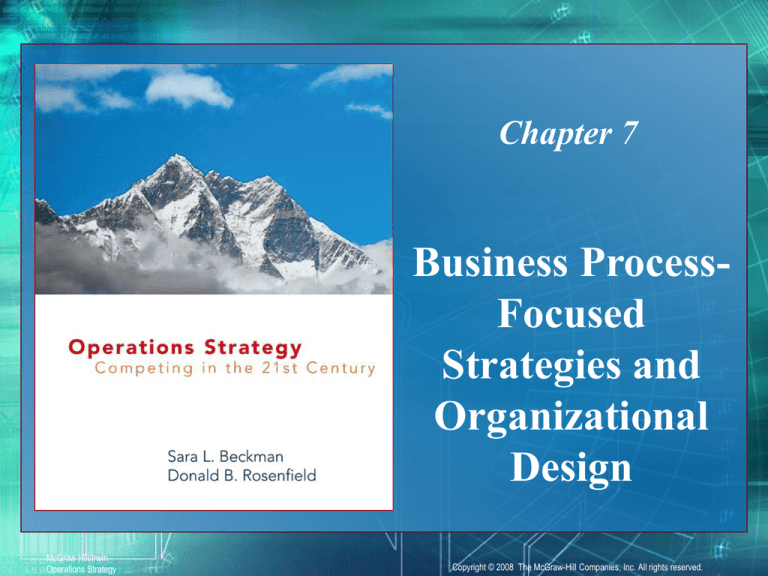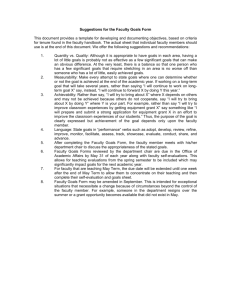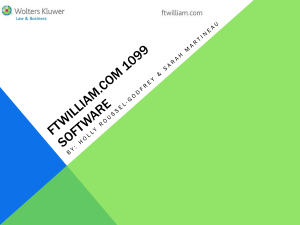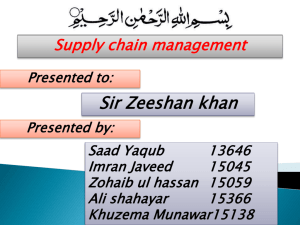
Chapter 7
Business ProcessFocused
Strategies and
Organizational
Design
McGraw-Hill/Irwin
Operations Strategy
Copyright © 2008 The McGraw-Hill Companies, Inc. All rights reserved.
7-1
Business Process Strategy and
Organizational Design Questions
On which business processes should the
company focus to achieve success in the
market?
How should the company align its resources
and capabilities to optimize performance of
the business processes?
7-2
Business Process Management: Principles
of Business Process Re-engineering
Organize around outcomes, not tasks
Prioritize all of the processes in the organization in
order of redesign urgency
Integrate information processing with the work
that produces the information
Treat geographically dispersed resources as
though they were centralized
Link parallel activities in the workflow instead of
just integrating their outputs
Move decision-making to where the work is
performed, and build control into the process
Capture information once and at the source
7-3
Business Process Management: Functional
versus Process-Based Views
7-4
Business Process Management:
Definition of a Process
7-5
Business Process Management:
Process Mapping
7-6
Business Process Management: A
Process Mapping Example
7-7
Business Process Management: A
Process Mapping Example
7-8
Operations-Related Business
Processes
Product and service generation
Order fulfillment and processing
Service and support
7-9
Product and Service Generation:
Portfolio Management
7-10
Product and Service Generation:
Generic Process
7-11
Product and Service Generation:
Elements of the Development System
7-12
Product and Service Generation:
Metrics
7-13
Product and Service Generation:
Organizational Design
7-14
Order Fulfillment and Processing:
Generic Process
7-15
Order Fulfillment and Processing:
Metrics
Perfect Order Fulfillment – the percentage of orders
delivered "on time and in full" to request date and/or to
commit date
that meet the customer's three-way match (invoice,
purchase order, and receipt)
have no product quality issues
Metrics commonly used to measure “on time and in
full”
Line Fill Rate – percentage of lines on an order filled in full
Order Fill Rate – percentage of orders filled in full
Order Fulfillment Cycle Time - the amount of time
from customer authorization of a sales order to the
customer receipt of product
7-16
Order Fulfillment and Processing:
Organizational Design
Form cross-functional teams or task forces to
map and improve the process
Designate a champion or leader tasked with
the performance of the process
7-17
Order Fulfillment and Processing:
Information Technology Example
7-18
Order Fulfillment and Processing:
Information Technology Example
7-19
Service and Support: Process
7-20
Service and Support: Metrics
Speed of service
Quality of service
Customer satisfaction with service result
7-21
Service and Support: Organizational
Design
Form cross-functional teams or task forces to
map and improve the process
Designate a champion or leader tasked with
the performance of the process
7-22
Service and Support: Information
Technology
Spare parts management systems
Parts
Parts
Parts
Parts
Parts
demand planning
inventory planning
supply planning
distribution planning
monitoring
Service order management
Service contract management
Complaints and returns
In-house repair
Case management
Installed base management
Warranty management
Resource planning
Customer relationship management systems
Call center management systems
7-23
Organizational Design of Operations
Organizational structure
Decision-making processes
Human resources management
Incentives and rewards
7-24
Organizational Design of Operations:
Information Processing View
When there is little uncertainty, coordinate
work through:
Rules or programs
Hierarchy
Targets or goals
When uncertainty increases, redesign the
organization with:
Slack resources
Self-contained tasks
Vertical information systems
Lateral linkages or relationships
7-25
Organizational Design of Operations:
Corporate Organizational Structures
7-26
Organizational Design of Operations:
Organizing in Teams
7-27
Developing a Business Process
Focus
Scope the effort
Assign a process owner
Establish a cross-functional design team
Do the process design
Build buy-in at both management and
working levels
7-28
Developing an Organizational
Design
Identify key stakeholders and their interests
Understand the business context
Identify the key dimensions of organizational
focus
Create an organizational design and
implement
Measure human resource performance for
that organization
Measure the long-term impacts of the design
Adjust the organization design
7-29
Developing an Organizational
Design
7-30




